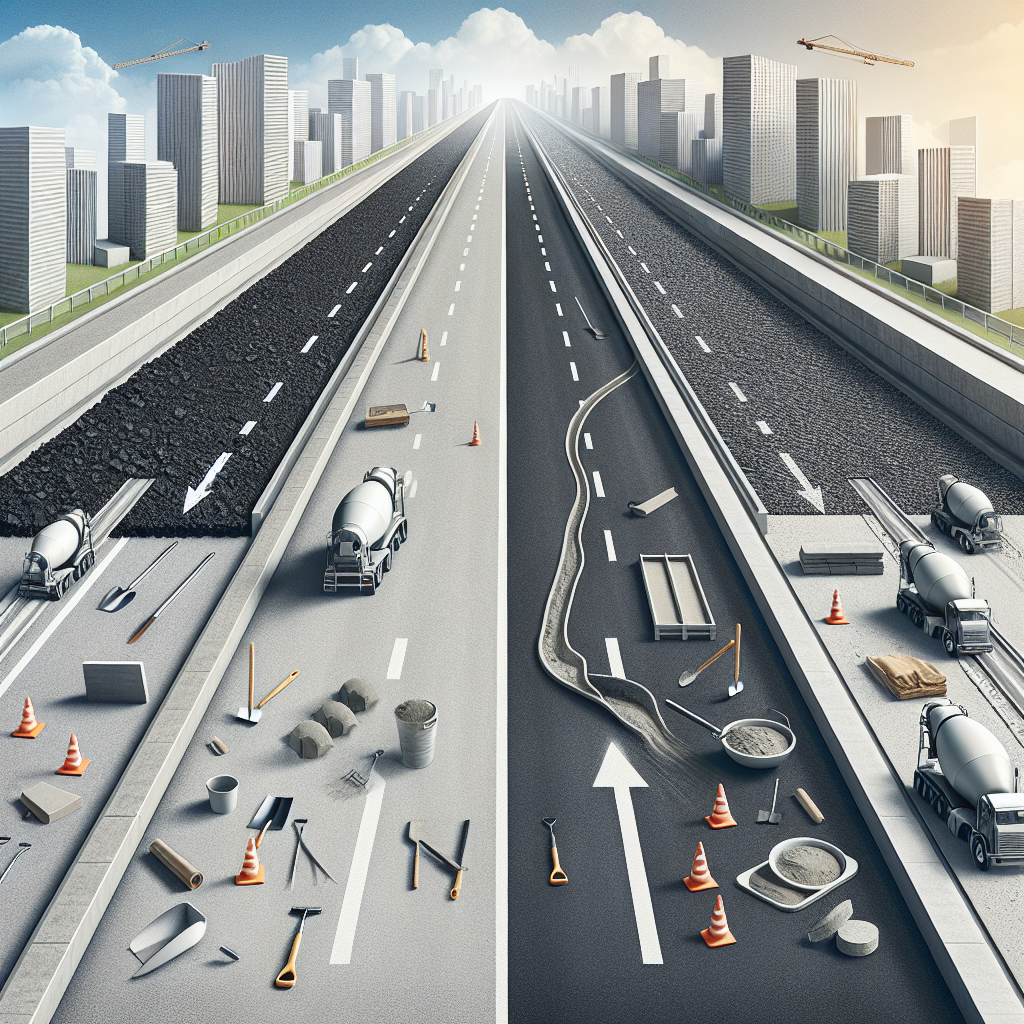When it comes to paving your driveway, parking lot, or any pathway, two materials often take center stage: concrete and asphalt. While both serve the essential function of providing a durable surface, they come with different properties, costs, and longevity prospects. This article will delve deep into the world of concrete and asphalt, offering a comprehensive guide to help you make an informed choice.
Understanding the Basics: Concrete vs. Asphalt
What is Concrete?
Concrete is a composite material made from cement, water, and aggregates such as sand, gravel, or crushed stone. Known for its strength, concrete is widely used in construction, from buildings to roads. Its solid, stone-like appearance gives it a classic aesthetic that many homeowners and businesses prefer.
What is Asphalt?
Asphalt, on the other hand, is a mixture of aggregates and a binding agent, typically bitumen. It is most commonly used for paved surfaces like roads and driveways due to its smooth finish and flexibility. Asphalt is also known for its quick installation and shorter curing time compared to concrete.
Installation Process: A Side-by-Side Comparison
Concrete Installation
The process of installing concrete is intricate and requires patience. Here’s a general overview:
- Preparation: The area must be excavated and graded to ensure proper drainage.
- Formwork: Wooden or metal forms are set up to shape the concrete while it cures.
- Pouring: The concrete mixture is poured into the forms, leveled, and smoothed.
- Curing: Concrete requires time to cure, typically about 28 days, to reach its full strength. During this time, it needs to be kept moist.
Asphalt Installation
Installing asphalt is generally faster and less labor-intensive:
- Preparation: Similar to concrete, the area is excavated and graded.
- Base Layer: A gravel base is often laid down to improve durability and drainage.
- Paving: The asphalt mixture is heated and laid onto the surface, normally needing just one or two layers.
- Cooling: Asphalt cools quickly, making it usable within a matter of hours.
Cost Considerations: Is It Worth Your Investment?
Initial Costs
When assessing costs, concrete usually has a higher upfront price ranging from $4 to $8 per square foot, while asphalt tends to average around $2 to $6 per square foot. Therefore, if you’re operating on a tight budget, asphalt might initially seem like the more attractive option.
Long-Term Value
While asphalt may be cheaper initially, it requires more frequent maintenance compared to concrete. Within the first few years, asphalt surfaces generally need seal coating and may require repairs due to cracking, which can add to your long-term costs. Conversely, concrete, while more expensive to install, has a longer lifespan—up to 30 years if properly maintained—making it a better long-term investment.
Maintenance Needs: The Care You’ll Need to Provide
Concrete Maintenance
- Sealing: It’s recommended to seal concrete every 3-5 years to prevent water infiltration and stains.
- Crack Repair: Small cracks can be filled with specific compounds designed for concrete repair.
Asphalt Maintenance
- Sealcoating: Asphalt should be seal coated every 2-3 years to protect against UV rays and weather elements.
- Routine Repairs: Regular inspections can catch cracks early before they turn into large potholes.
Longevity and Durability: A Clash of Titans
Concrete Longevity
When it comes to longevity, concrete takes the lead. With proper care, concrete can last anywhere from 25 to 30 years or even more. Its resistance to wear and tear also makes it suitable for heavy vehicles, making it a go-to choice for commercial applications.
Asphalt Longevity
Asphalt, while durable, typically lasts for about 15 to 20 years. Its softer surface means that it can become susceptible to damage from extreme heat and rainfall if not properly maintained. However, its flexibility allows it to better withstand the impacts from heavy loads over a shorter lifespan.
Aesthetic Appeal: Choosing What Fits Your Style
Concrete Aesthetics
Concrete comes with a variety of finishes, colors, and textures. Stamped or colored concrete can enhance attractiveness, making it a popular choice for homeowners looking to boost curb appeal.
Asphalt Aesthetics
Asphalt presents a sleek, matte finish that many find appealing, but it generally lacks the decorative options that concrete provides. However, certain types of asphalt can be mixed with colored aggregates for a more customized look.
Environmental Considerations: Go Green with Knowledge
Both concrete and asphalt come with their own environmental impacts.
Concrete’s Environmental Footprint
Concrete production generates considerable CO2 emissions. However, it is also recyclable, and reclaimed concrete can be repurposed in new projects.
Asphalt’s Green Credentials
Asphalt also has a lower carbon footprint due to its ability to be recycled. Approximately 90% of asphalt is recycled in the U.S., making it a sustainable choice.
Conclusion: Your Path Ahead
Choosing between concrete and asphalt is not a one-size-fits-all decision. Each material has unique advantages and disadvantages that cater to different needs, budgets, and aesthetics. If you’re looking for longevity and are prepared to invest more upfront, concrete may be the way to go. Alternatively, if you need a quick, cost-effective solution with manageable maintenance, asphalt is likely your best bet.
No matter which path you choose, understanding your options will save you time and money in the long run. Happy paving, and may your chosen surface stand up to the test of time!


